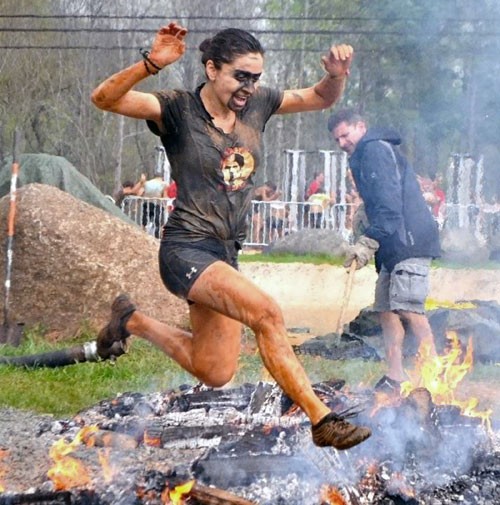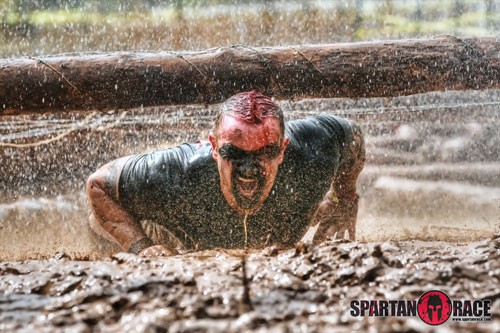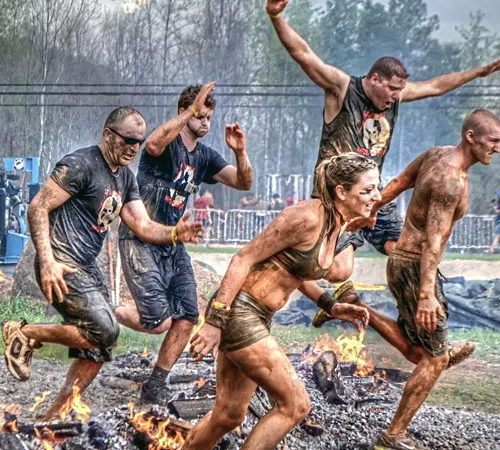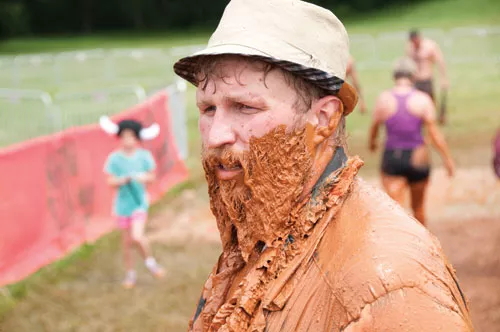Nicole McConnell drops off and picks up her two little boys at school every day. She makes her family dinner. She teaches at a local high school. By most accounts, she is the ideal suburban housewife from Matthews.
But one day last August, McConnell grew weary of her "nice little vanilla life."
"It's not like anyone's saying to themselves, 'The way you crock-pot, lady, that's bad-ass,'" McConnell says. She started working out and in May completed a Warrior Dash with her husband.
Obstacle races and mud runs have become increasingly popular in the Charlotte area, particularly Warrior Dash, Tough Mudder and Spartan. They vary in length, with the least extreme, Warrior, spanning about 3 miles and the most, Spartan, about 12. The races include obstacles a kid only wishes were in a playground. Over a 3.1-mile course, 32-year-old McConnell climbed a 12-foot wall and slid, harness-free, down a firemen's pole, crawled in mud under barbed wire and jumped over three fire pits.
"I don't have a 12-foot wall in my backyard." The race, she says, was "the safe way to let loose."
Equal parts action-adventure and psychological thriller, the events are as physically challenging as they are mentally grueling. And on paper, their popularity makes no sense. Participants pay up to $200 to get physically exhausted and put themselves in harm's way for hours. When asked, race spokespeople are quick to emphasize — and defend — the safety measures that go into the events, such as lifeguards stationed at water obstacles. While sprained ankles, broken fingers, scrapes and bruises are common, death is rare. Still, many obstacle and mud race websites boast the possibility of bodily harm or death, with heavy-metal riffs ripping as you scroll.
Some races are designed to keep participants from crossing the finish line. Tough Mudder co-founder Will Dean told a Bloomberg TV reporter in November 2011 that he created obstacles that even some marathoners, ultra-marathoners and triathletes couldn't finish. "There's going to be one that breaks you," the Harvard Business School- and British Special Forces-trained Dean told the reporter. "People are paying us to get that experience."
So far, he's been right. A little more than three-fourths of participants cross the finish line — those who do are exhausted and probably bleeding — and yet, the total number of runners has grown from 20,000 in 2010, when the race began, to already 460,000 this year.
"You look back on something you did as a kid, and you're like, 'Wow, that was nuts,'" says Charlotte sports psychologist Brian Monteleone. Nuts, but fun. "Some of it taps into adolescent drives, where [you believe death] isn't going to happen to you."
Neither McConnell nor anyone else I interview has ever broken a bone or panicked, but most know of someone who has. McConnell spent part of her race comforting a woman who froze while on a climbing wall. "Every obstacle presented something that was a little out of your comfort zone," she says. For her, it was leaping from that wall to a fireman's pole, the only way down save for jumping 12 feet. The jarring experience was worth the price. "I want my two little boys, when I'm old and decrepit, to say, 'My mom was awesome.'"
Twenty pounds lighter than she was last August, McConnell says the race has also motivated her to train for half and full marathons.
For others, the events tap into what Monteleone calls the "athletic identity," a permanent component of someone's personality developed by playing sports. It's the trait that attracts some people to the mental and physical challenges of team-building activities. Obstacle races and mud runs — different in definition only by the presence of wet dirt — mostly appeal to Type A's: people who are packed with self-motivation and competitiveness, and who enjoy variety in their activities. Those people are different from obsessive-compulsive marathoners and triathletes, who tend to thrive more on redundancy and routine.

-
Hulya Erbas (Photo by Sam Brake)

-
Sam Brake

-
From left, Marco Ozdemir, Nick Mason, Nate Sallach and Jessica Nelso participate in a Spartan race. (Photo by Sam Brake)
MUSCLES JACKED and hair buzzed, Sam Brake looks every bit the ex-Marine. I meet him and a few other men from his race team, Spartan Mud Mafia, in the lobby of a South End apartment complex in early October. Some members, like Nick Mason, a 26-year-old lawyer, look like they belong around a conference table. Brake, 42, doesn't. Neither does Marco Ozdemir, a 38-year-old Turk who once played bass in a speed-metal band but now has his hands in e-commerce. Nor does 40-year-old Ryan McDuffee, who designs playgrounds for a living.
Their backgrounds vary, but they share at least two commonalities: They look good shirtless and they love adrenaline.
Brake left the Marines in '94 and spent years looking for something to replace the camaraderie. "In the Marine Corps, you go to combat — it's a brotherhood," Brake says. "I've tried starting [sports] teams, and this is another way of building that."
Brake, Ozdemir and Mason got together and ran a 5.2-mile Spartan race, officially formed a team in January, came up with their Spartan Mud Mafia name and logo and then started recruiting. Some of the 50 members, about half of whom are women, ran the Carolinas Spartan Beast race this past Saturday.
Monteleone likens the exhilaration and sense of accomplishment a racer gets after crossing the finish line to watching the birth of a child. "Those are exhilarating experiences that don't happen regularly," he says. "They tap into extraordinary drives that we have that are out of the norm."
The races also serve up major bragging rights. When I bring up to the men of Spartan Mud Mafia that Dean, the Tough Mudder co-founder, said some people use their participation in grueling obstacles as pick-up lines at bars, most around the table chuckle in semi-acknowledgement. But not Brake. "No one's got an ego. We're a peaceful group of people who like outdoor activities."

-
A participant after the Warrior Dash in May in at Rural Hill. (Photo by Jeffrey Oyler)
I DON'T PARTICULARLY enjoy outdoor activities — I have the hand-eye coordination of a blind golden retriever — so I feel sorry for Adam Bratton. He's the U.S. Whitewater Center's sponsorship and events coordinator who has agreed to take me around a rope course to provide the safest possible taste of an actual obstacle race. The center counted more than 6,000 participants at its first Spartan race in March and will host another next year assuming contracts are signed.
Bratton and I meet on a humid Tuesday before the sun has burned away the morning fog. The Whitewater Center is peaceful at this time, filled only with birds and lawn mowers. I anxiously pace in front of the outfitter store in anticipation of Bratton's arrival. I could make my way, slowly and painfully, around an obstacle course. My problem is heights, a random fear that didn't bother me at the top of a World Trade Center tower when I visited New York City as a kid, but sends me into a paroxysm of terror on a step ladder. I'd be the girl having a panic attack at the top of that wall during McConnell's race.
Bratton rounds the corner, and instead of the beef jerky-chewing, mountain-climber-equipment-lugging hippie I had pictured, he actually looks like — and has the competitive drive of — a college quarterback. Poor pretty boy.
He is partially responsible for bringing more races to the center, including the first annual Dirty Dozen this past weekend. His first obstacle race was a Super Spartan in June 2010, and he has completed a few triathlons, or "tris," as he calls them. His goal is to run a half marathon in all 50 states. So far, he's run nine.
We make our way to the ropes, a short, easy course whose netted canopies and swings mimic a few of the obstacles in real races. The first challenge is a net blanket that peaks like a hill some 15 feet above ground. Bratton jumps on, explaining as he climbs how and where I should place my limbs when it's my turn. He makes it look easy. I'm on the verge of tears. I swallow hard and extend a shaky hand somewhere in front of me, hoping the net doesn't break or that I don't topple over.
The rope is actually more supportive than I think. Another hand goes out, and my feet follow. I'm hardly Spider Man, but I haven't passed out. I get to the top, round the peak, and make my way down. It suddenly occurs to me that I was laughing the entire time.
We traverse through the remainder of the course without calamity. I decide the final obstacle, a climbing rope complete with a cowbell, is too much for my weak arms after Bratton admits it is difficult even for him. I had heard from other race participants that upper-body strength is just as important, if not more, as endurance, so I'm comforted by Bratton's admission: If he couldn't do it, maybe I shouldn't feel so down on myself.
Faster than I can say "There's always next year, champ," Bratton jumps on the rope, shimmies to the top, rings the bell and comes back down. Perhaps detecting my sense of defeat, he looks at me and says, "Just think about it this way: When have you ever laughed on a treadmill?"